 |
市场调查报告书
商品编码
1456200
物联网企业专案实施报告:2024IoT Enterprise Projects Adoption Report 2024 |
||||||
本报告运用对物联网解决方案最终使用者的全面调查,深入探讨物联网公司有关业务采用的策略决策过程。本文详细分析了已执行的用例、投资回报 (ROI)、面临的课题和吸取的经验教训。本书也提供了40 多个用例的见解,帮助您瞭解物联网解决方案的购买、建置或两者兼而有之的决策。此外,还包括对购买现成解决方案的详细分析。数据呈现来自北美、欧洲和亚太地区超过 15 个国家的观点。
样本视图

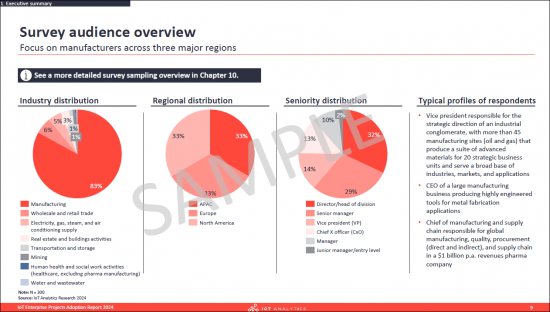
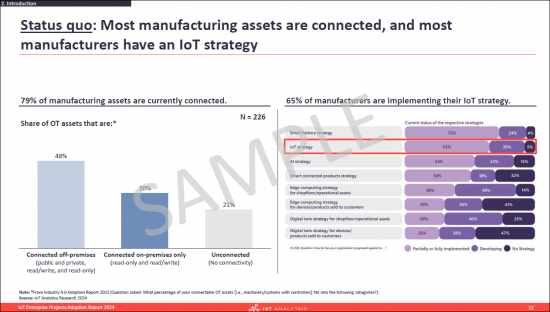
样本视图
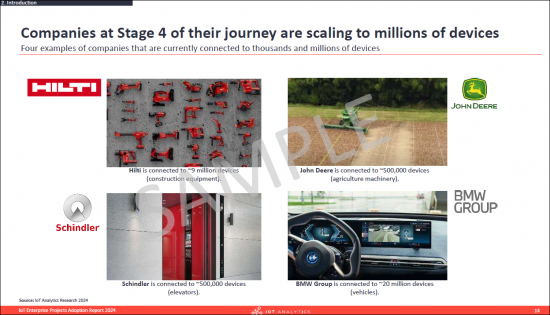

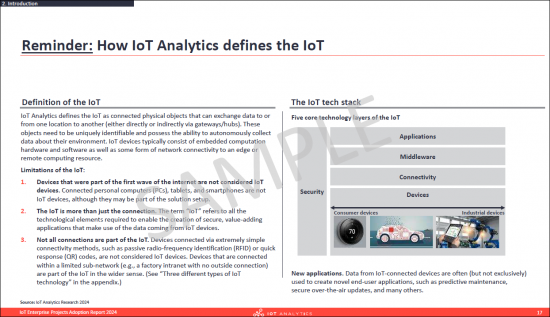
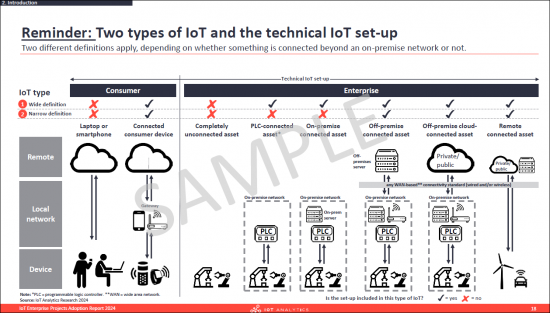
已回答的问题
- 企业物联网计画有多成功?哪些措施更成功?
- 这种物联网实施的投资报酬率是多少?您已经达到收支平衡点了吗?
- 实施物联网计划的主要方法是什么?建造、购买还是购买?
- 特定方法的决策是如何做出的?最重要的考虑因素是什么?
- 这三种方法在产业、地区、用例组和公司规模上有何不同?
- 引入物联网时,您必须克服哪些人力资源和组织课题?
- 让关键组织团体参与实施计画的过程有多重要?
- 组织从实施此类措施中学到了哪些重要经验教训?
- 每种方法执行哪些用例:购买还是建置?
目录
第一章概要/研究亮点
第二章简介
第 3 章 物联网措施的现状
- 1.物联网措施的现况 - 概述和要点
- 2. IoT 计画时间表概述
- 3.互联产品对OEM收入的贡献(3/3)-规模/顾客类型
- 4.物联网规划每个阶段所需的时间
- 5.成功的物联网举措
- 6.终止/暂停正在进行的计划的原因
第 4 章 商业案例
- 1.业务案例概述与要点
- 2.商业案例的角色(1/2):总体
- 3.业务案例的角色 (2/2):依用例/倡议类型
- 4.利害关係人参与
- 5.专案投资报酬率(1/3):概述
- 6.专案投资报酬率 (2/3):依方法、开始年份及使用案例组
- 7.专案投资报酬率(3/3):用例(1/3)-智慧运营
- 8.专案投资报酬率(3/3):用例(2/3)-智慧供应链
- 9.专案投资报酬率 (3/3):使用案例 (3/3) - 相关产品
第 5 章 购买与建造与购买并构建
- 1.购买与建造与购买并建构:概述/要点
- 2. IIoT 解决方案开发 (1/2):购买 vs. 构建 vs. 购买并构建
- 3. IIoT 解决方案开发 (2/2):购买与建造与购买和建造:主要提及
- 4.采用的方法(1/4)-依规模和行业
- 5.采取的方法 (2/2) - 依区域
- 6.采用的方法 (3/4) - 直至结束日期
- 7.采用的方法 (4/4) - 依用例 (1/3):智慧运营
- 8.采用的方法 (4/4) - 依用例 (2/3):智慧供应链
- 9.采用的方法 (4/4) - 依用例 (3/3):互联产品/设备
- 10.选择每种方法的主要原因
- 11.专案成功:依方法
- 12.为什么选择 "自订建置" 方法(1/4):概述
- 13.为什么选择 "自订建造" 方法 (2/4) – 依地区
- 14.为什么选择 "客製化" 方法(3/4)-以行业
- 15.为什么选择 "客製化建造" 方法(4/4)-依规模
- 16.为什么选择 "购买并建造" 方法 (1/4) - 概述
- 17.为什么选择 "购买并建造" 方式(2/4)-以地区
- 18.为什么选择 "购买并建造" 方法 (3/4) – 依行业
- 19.为什么选择 "购买并建造" 方法 (4/4) – 依规模
- 20.选择 "购买" 方式的原因(1/4):概述
- 21.为什么选择 "购买" 方式(2/4)-依地区
- 22.为什么选择 "购买" 方式(3/4)-以行业
- 23.选择 "购买" 方式的原因 (4/4) – 依规模
第六章 详细分析:现成的解决方案
- 1.详细分析:现成方案概述及要点
- 2.选择 "购买" 解决方案时因素的重要性
- 3.选择 "购买" 供应商时因素的重要性
- 4.选择供应商时与供应商的现有关係的重要性
- 5.与系统整合商的合约
- 6.物联网解决方案供应商应涉及的主要联络人(1/2)
- 7.物联网解决方案供应商应涉及的主要联络人 (2/2)
- 8.否决权
- 9.整合 "采购" 解决方案时最大的课题
第 7 章 重要教训
- 1.主要课程 - 概述/要点
- 2.倡议过程中需要克服的课题(1/3)-概述
- 3.专案期间要克服的课题(2/3)-直到结束日期
- 4.倡议期间要克服的课题(3/3)-依类型
- 5.倡议期间需要克服的人力资源和组织问题
- 6.物联网计画相对长期部署面临的课题
- 7.主要课程(1/5):概述
- 8.主要课程(2/5):综合课程
- 9.重点课程(3/5):采购与建造程度
- 10.主要经验教训 (4/5):供应商选择
- 11.关键经验教训 (5/5):建立内部项目
- 12.值得注意的物联网举措 (1/5) - 简介
- 13.着名的物联网举措 (2/5) - 依用例群组
- 14.值得注意的物联网举措 (3/5) - 依用例 (1/3):智慧运营
- 15.着名的物联网举措 (3/5) - 依用例 (2/3):智慧供应链
- 16.着名的物联网举措 (3/5) - 依用例 (3/3):互联产品
- 17.值得注意的物联网措施 (4/5) - 依方法
- 18.值得注意的物联网措施 (5/5) - 依行业
- 19.为什么有些公司实现了惊人的快速部署
第8章研究方法论
第 9 章. 关于 IoT 分析
The "IoT Enterprise Project Adoption Report 2024" is part of IoT Analytics' ongoing coverage of general IoT topics. The information presented in this report is based on an extensive survey of decision makers in manufacturing and other sectors such as energy and buildings. Its purpose is to inform other market participants about the current state of implementation of IoT initiatives in the enterprise sector and the approach they are following. Survey participants were selected randomly, and their knowledge was verified independently. To ensure complete objectivity, IoT Analytics did not alter or supplement any survey results and did not accept participants that were suggested by third parties (e.g., customers from specific vendors).
SAMPLE VIEW



Leveraging a comprehensive survey encompassing end users of IoT solutions, this report delves into the strategic decision-making processes pertaining to IoT enterprise business adoption. It offers an in depth analysis of implemented use cases, return on investment (ROI), challenges encountered, and learnings. The report provides insights for over 40 use cases, providing a better understanding of the decisions between buying, building, or combining both approaches for IoT solutions. A deep dive of purchasing off-the-shelf solutions is also included. The data represents perspectives from over 15 countries across North America, Europe, and the Asia-Pacific region. Each participant contributed to the depth of this report by answering more than 30 targeted questions about their IoT initiatives, ensuring a robust foundation for market research in the IoT enterprise domain.
SAMPLE VIEW




Questions answered:
- How successful are enterprise IoT initiatives? Which ones are more successful?
- What is the ROI of such IoT implementations? Have they already reached break-even?
- What is the dominant approach to implement IoT initiatives? Build, buy-and-build, or buy?
- How are decisions for a specific approach made? What are the most important considerations?
- How do the three approaches vary by industry, region, use case group, and company size?
- What people and organizational challenges had to be overcome during the IoT implementation?
- How important is it to involve key organizational groups in the process of implementing the initiative?
- What are some of the key learnings that organizations have taken from implementing such initiatives?
- Which use cases are implemented with each buy vs. build approach?
Table of Contents
1. Executive summary and survey highlights
- 1. This report analyzes 300 IoT initiatives
- 2. Survey audience overview
- 3. Executive summary
- 4. Highlight: Four key insights from the analysis performed in the report
2. Introduction
- 1. Status quo: Most manufacturing assets are connected, and most manufacturers have an IoT strategy
- 2. Our view: Many companies are in or moving to Stage 4 of their IoT journey
- 3. Companies at Stage 4 of their journey are scaling to millions of devices
- 4. However, IoT solutions are often not one-size-fits-all
- 5. This report distinguishes three main approaches to developing IoT solutions
- 6. Reminder: How IoT Analytics defines the IoT
- 7. Reminder: Two types of IoT and the technical IoT set-up
3. State of IoT initiatives
- 1. State of IoT initiatives-overview and key takeaways
- 2. Overview of IoT initiative timelines
- 3. Contribution of connected products to OEM revenue (3/3)-size/customer type
- 4. Time needed for each phase of the IoT initiative
- 5. Success of IoT initiatives
- 6. Reasons for terminating/pausing an ongoing initiative
4. Business case
- 1. Business case-overview and key takeaways
- 2. Role of the business case (1/2): Overall
- 3. Role of the business case (2/2): By use case and initiative type
- 4. Stakeholder involvement
- 5. Project ROI (1/3): Overview
- 6. Project ROI (2/3): By approach, start year, and use case group
- 7. Project ROI (3/3): By use case (1/3)-smart operations
- 8. Project ROI (3/3): By use case (2/3)-smart supply chain
- 9. Project ROI (3/3): By use case (3/3)-connected products
5. Buy vs. Build vs. Buy-&-Build
- 1. Buy vs. build vs. buy-and-build-overview and key takeaways
- 2. IIoT solution development (1/2): Build vs. buy-and-build vs. buy
- 3. IIoT solution development (2/2): Build vs. buy-and-build vs. buy-key quotes
- 4. Approach taken (1/4)-by size and industry
- 5. Approach taken (2/2)-by region
- 6. Approach taken (3/4)-by end date
- 7. Approach taken (4/4)-by use case (1/3): Smart operations
- 8. Approach taken (4/4)-by use case (2/3): Smart supply chain
- 9. Approach taken (4/4)-by use case (3/3): Connected products/devices
- 10. Top reasons to decide on a respective approach
- 11. Project success by approach
- 12. Reasons to go for the "custom-build" approach (1/4): Overview
- 13. Reasons to go for the "custom-build" approach (2/4)-by region
- 14. Reasons to go for the "custom-build" approach (3/4)-by industry
- 15. Reasons to go for the "custom-build" approach (4/4)-by size
- 16. Reasons to go for the "buy-and-build" approach (1/4)-overview
- 17. Reasons to go for the "buy-and-build" approach (2/4)-by region
- 18. Reasons to go for the "buy-and-build" approach (3/4)-by industry
- 19. Reasons to go for the "buy-and-build" approach (4/4)-by size
- 20. Reasons to go for the "buy" approach (1/4): Overview
- 21. Reasons to go for the "buy" approach (2/4)-by region
- 22. Reasons to go for the "buy" approach (3/4)-by industry
- 23. Reasons to go for the "buy" approach (4/4)-by size
6. Deep-dive: Off-the-shelf solutions
- 1. Deep dive: Off-the-shelf solutions-overview and key takeaways
- 2. Importance of factors when selecting the "buy" solution
- 3. Importance of factors when selecting the "buy" vendor
- 4. Importance of existing relationship with vendors when choosing a provider
- 5. Contracting a system integrator
- 6. Key contacts that IoT solution vendors should engage with (1/2)
- 7. Key contacts IoT solution vendors should engage with (2/2)
- 8. Right of refusal
- 9. Most painful aspects when integrating the "buy" solution
7. Key learnings
- 1. Key learnings-overview and key takeaways
- 2. Challenges to overcome during initiative (1/3): Overview
- 3. Challenges to overcome during initiative (2/3)-by end date
- 4. Challenges to overcome during initiative (3/3)-by type
- 5. People and organizational challenges to overcome during an initiative
- 6. Challenges faced leading to a relatively long deployment of the IoT initiative
- 7. Key learnings (1/5): Overview
- 8. Key learnings (2/5): Overarching learnings
- 9. Key learnings (3/5): Degree of buy vs. build
- 10. Key learnings (4/5): Choice of suppliers
- 11. Key learnings (5/5): Internal project set-up
- 12. Remarkable IoT initiatives (1/5): Introduction
- 13. Remarkable IoT initiatives (2/5): By use case group
- 14. Remarkable IoT initiatives (3/5)-by use case (1/3): Smart operations
- 15. Remarkable IoT initiatives (3/5)-by use case (2/3): Smart supply chain
- 16. Remarkable IoT initiatives (3/5)-by use case (3/3): Connected products
- 17. Remarkable IoT initiatives (4/5)-by approach
- 18. Remarkable IoT initiatives (5/5)-by industry
- 19. Why some companies achieved a remarkably fast roll-out













